Biology
(
İngilizce
)
Arkive tarafından sağlandı
The highly adaptive beaks of Darwin's finches enable each species to occupy a different ecological niche based on different food types (2) (4). The foraging behaviour of the common cactus-finch varies with the seasons, but when Opuntia cacti are flowering, the adults use their specialised beaks to feed almost exclusively on the pollen and nectar obtained from the flowers (4) (8). At other times of the year, Opuntia fruits and seeds become important components of its diet, and during the rainy season, this finch will take advantage of various additional sources of food, such as shoots, berries, seeds, caterpillars and budworms (8)
Darwin's finches generally breed opportunistically with egg-laying being most profuse when rainfall is high and food abundant (2). Pairs are typically monogamous and maintain small territories within which they build a small dome-shaped nest in a bush or cactus. On average each clutch comprises three to four eggs that are incubated for around 12 days before hatching. The nestlings are mostly raised on pollen, nectar and insects, and leave the nest after about two weeks (4) (9).
During the breeding season, competition for resources between different species of finch can be extremely intense. In promoting ever increasing levels of specialisation, competition for resources has been the driving force behind the evolution of Darwin's finches. This is exemplified by the widely divergent beak sizes of different finch species co-inhabiting one island, compared with much more convergent beak sizes when the same species are isolated from each other on separate islands (4). Long term studies of Darwin's finches on the island of Daphne Major have provided compelling evidence of evolution in action. Over a period of several decades, the beak morphology of the island's common cactus-finch population has fluctuated in response to changes in the prevalent food source following climatic events (10) (11) (12).
Conservation
(
İngilizce
)
Arkive tarafından sağlandı
For their unique biological diversity and significance, the Galapagos Islands are designated both a National Park and a World Heritage Site. As a consequence, conservation of the islands' native fauna and flora is a high priority (15). Furthermore,scientists from the Charles Darwin Foundation continue to conduct further research on Darwin's finches in order to ensure their long-term conservation (13).
Description
(
İngilizce
)
Arkive tarafından sağlandı
Although the mockingbirds of the Galapagos arguably had a greater influence on Darwin's theory of natural selection (3), it is a group of fourteen closely related finches that famously bear his eponym (2) (4). One of the most well known of Darwin's finches, and one that the eminent naturalist initially mistook for a kind of blackbird, is the common cactus-finch (4) (5). Like the other ground finches (Geospiza sp.) the adult male plumage of the common cactus finch is usually completely black, while the female is brown and streaked (2). The long, pointed beak of the common cactus-finch enables it to exploit food sources less accessible to the other finches (2) (4) (6).
Habitat
(
İngilizce
)
Arkive tarafından sağlandı
Occurs mainly in the arid lowland zone on each island, particularly where Opuntia cacti are abundant (7) (8).
Range
(
İngilizce
)
Arkive tarafından sağlandı
The common cactus finch is endemic to the Galápagos where it occurs on the islands of Pinta, Marchena, Floreana, San Cristóbal, Santa Fe, Daphne Major, Santa Cruz, Pinzón, Rábida, Santiago, Isabela, Baltra and Seymour (2).
Status
(
İngilizce
)
Arkive tarafından sağlandı
Classified as Least Concern (LC) on the IUCN Red List (1).
Threats
(
İngilizce
)
Arkive tarafından sağlandı
Like much of the Galapagos' endemic fauna and flora, Darwin's finches are under threat from habitat destruction, introduced diseases, and invasive predatory species such as rats and cats (13). Fortunately, the common cactus-finch is still relatively abundant in parts of its range and currently is not thought to be undergoing a significant decline (14).
Geospiza scandens
(
Asturyasça
)
wikipedia AST tarafından sağlandı
-
 Les especies d'aves con nome común en llingua asturiana márquense como NOA. En casu contrariu, conséñase'l nome científicu o de la SEO.
Les especies d'aves con nome común en llingua asturiana márquense como NOA. En casu contrariu, conséñase'l nome científicu o de la SEO.
Geospiza scandens ye una especie d'ave de la familia Thraupidae.
Estes aves son reinales de les Islles Galápagos, na islla Santa Cruz. El so hábitat natural son les selves tropicales o subtropicales.
Alimentación
Esta especie aliméntase d'inseutos.
Enllaces esternos
 Esta páxina forma parte del wikiproyeutu Aves, un esfuerciu collaborativu col fin d'ameyorar y organizar tolos conteníos rellacionaos con esti tema. Visita la páxina d'alderique del proyeutu pa collaborar y facer entrugues o suxerencies.
Esta páxina forma parte del wikiproyeutu Aves, un esfuerciu collaborativu col fin d'ameyorar y organizar tolos conteníos rellacionaos con esti tema. Visita la páxina d'alderique del proyeutu pa collaborar y facer entrugues o suxerencies.
- lisans
- cc-by-sa-3.0
- telif hakkı
- Wikipedia authors and editors
Geospiza scandens: Brief Summary
(
Asturyasça
)
wikipedia AST tarafından sağlandı
Geospiza scandens 
Les especies d'
aves con
nome común en
llingua asturiana márquense como
NOA. En casu contrariu, conséñase'l nome científicu o de la
SEO.
Geospiza scandens ye una especie d'ave de la familia Thraupidae.
Estes aves son reinales de les Islles Galápagos, na islla Santa Cruz. El so hábitat natural son les selves tropicales o subtropicales.
- lisans
- cc-by-sa-3.0
- telif hakkı
- Wikipedia authors and editors
Pinsà terrestre dels cactus
(
Katalanca; Valensiyaca
)
wikipedia CA tarafından sağlandı
- lisans
- cc-by-sa-3.0
- telif hakkı
- Autors i editors de Wikipedia
Pinsà terrestre dels cactus: Brief Summary
(
Katalanca; Valensiyaca
)
wikipedia CA tarafından sağlandı
El pinsà terrestre dels cactus (Geospiza scandens) és un ocell de la família dels tràupids (Thraupidae) que habita zones amb cactus de la major part de les illes Galápagos, estant absent de Fernandina.
- lisans
- cc-by-sa-3.0
- telif hakkı
- Autors i editors de Wikipedia
Pila daear cactws
(
Galce
)
wikipedia CY tarafından sağlandı
- lisans
- cc-by-sa-3.0
- telif hakkı
- Awduron a golygyddion Wikipedia
Pila daear cactws: Brief Summary
(
Galce
)
wikipedia CY tarafından sağlandı
Aderyn a rhywogaeth o adar yw Pila daear cactws (sy'n enw gwrywaidd; enw lluosog: pilaon daear cactws) a adnabyddir hefyd gyda'i enw gwyddonol Geospiza scandens; yr enw Saesneg arno yw Cactus ground finch. Mae'n perthyn i deulu'r Breision (Lladin: Emberizidae) sydd yn urdd y Passeriformes.
Talfyrir yr enw Lladin yn aml yn G. scandens, sef enw'r rhywogaeth.
- lisans
- cc-by-sa-3.0
- telif hakkı
- Awduron a golygyddion Wikipedia
Common cactus finch
(
İngilizce
)
wikipedia EN tarafından sağlandı
The common cactus finch or small cactus finch (Geospiza scandens) is a species of bird in the Darwin's finch group of the tanager family Thraupidae. It is endemic to the Galapagos Islands, where it is found on most islands, with the notable exception of Fernandina, Española, Genovesa, Darwin and Wolf. Most of these islands are inhabited by its close relative, the Española cactus finch.
Its natural habitats are dry scrubland and woodland. It is usually closely associated with the cactus Opuntia.
Taxonomy
The common cactus finch is one of nine species in the genus Geospiza, part of a group of closely related species known as Darwin's finches.[2] There are four recognized subspecies:
-
G. s. abingdoni is found on Pinta.[3]
-
G. s. intermedia is found on Santa Fé, Floreana, Santa Cruz, Isabela and Pinzón.[3]
-
G. s. rothschildi is found on Marchesa.[3]
-
G. s. scandens is found on Santiago and Rábida.[3]
Habitat and range
Found in the arid zone of many of the islands in the Galápagos, the common cactus finch is seldom far from areas of Opuntia cactus.[3]
References
Swash, Andy; Still, Rob (2005). Birds, Mammals and Reptiles of the Galápagos Islands (2nd ed.). London: Christopher Helm. ISBN 978-0-7136-7551-1.

- lisans
- cc-by-sa-3.0
- telif hakkı
- Wikipedia authors and editors
Common cactus finch: Brief Summary
(
İngilizce
)
wikipedia EN tarafından sağlandı
The common cactus finch or small cactus finch (Geospiza scandens) is a species of bird in the Darwin's finch group of the tanager family Thraupidae. It is endemic to the Galapagos Islands, where it is found on most islands, with the notable exception of Fernandina, Española, Genovesa, Darwin and Wolf. Most of these islands are inhabited by its close relative, the Española cactus finch.
Its natural habitats are dry scrubland and woodland. It is usually closely associated with the cactus Opuntia.
- lisans
- cc-by-sa-3.0
- telif hakkı
- Wikipedia authors and editors
Geospiza scandens
(
İspanyolca; Kastilyaca
)
wikipedia ES tarafından sağlandı
El pinzón de Darwin de los cactos,[2] pinzón cactero chico, pinzón cactero común o pinzón de Darwin de La Española (Geospiza scandens)[3] es una especie de ave paseriforme de la familia Thraupidae perteneciente al género Geospiza. Es endémico de las islas Galápagos en Ecuador. Pertenece al grupo denominado pinzones de Darwin.
Distribución y hábitat
Se encuentra en las mayores islas del archipiélago, en zonas áridas con presencia de cactos espinosos Opuntia donde es bastante común; raramente se aventura a mayor altitud, en zonas más húmedas.[4]
Alimentación
Se alimenta de la pulpa del cacto Opuntia, de flores, frutos e insectos. Principalmente de las semillas de Opuntia, que componen más de un tercio de su dieta, otro tercio compuesto por las flores del cacto, aproximadamente un cuarto consiste de otras pequeñas semillas y el resto porciones mínimas de artrópodos y semillas de Tribulus.[4]
Sistemática
![src=]()
Cactornis scandens, ilustración en Gould
The zoology of the voyage of H.M.S. Beagle.
Descripción original
La especie G. scandens fue descrita por primera vez por el naturalista británico John Gould en 1837 bajo el nombre científico Cactornis scandens; su localidad tipo es: «Isla James (actual Santiago), Islas Galápagos».[3]
Etimología
El nombre genérico femenino Geospiza es una combinación de las palabras del griego «geō», que significa ‘suelo’, y «σπιζα spiza» que es el nombre común del pinzón vulgar, vocablo comúnmente utilizado en ornitología cuando se crea un nombre de un ave que es parecida a un pinzón, ; y el nombre de la especie «scandens» en latín significa ‘, escalando, trepando’.[5]
Taxonomía
La presente especie raramente híbrida con Geospiza fortis.[4]
Subespecies
Según las clasificaciones del Congreso Ornitológico Internacional (IOC)[6] y Clements Checklist/eBird v.2019[7] se reconocen cuatro subespecies, con su correspondiente distribución geográfica:
Referencias
-
↑ a b Gould, J. (1837). «Remarks on a group of Ground Finches from Mr. Darwin's collection, with characters of New Species». Proceedings of the Zoological Society of London (en inglés y latín). Pt 5 no.49: 4–7. Cactornis scandens, descripción original p. 7. Disponible en Biodiversitas Heritage Library. ISSN 0370-2774.
-
↑ De Juana, E; Del Hoyo, J; Fernández-Cruz, M; Ferrer, X; Sáez-Royuela, R; Sargatal, J (2012). «Nombres en castellano de las aves del mundo recomendados por la Sociedad Española de Ornitología (Decimosexta parte: Orden Passeriformes, Familias Thraupidae a Icteridae)». Ardeola. Handbook of the Birds of the World (Madrid: SEO/BirdLife) 59 (1): 157-166. ISSN 0570-7358. Consultado el 13 de abril de 2019. P. 165.
-
↑ a b «Pinzón de Darwin de los cactos Geospiza scandens (Gould, 1837)». Avibase. Consultado el 14 de agosto de 2021.
-
↑ a b c Jaramillo, A. & Christie, D.A. (2020). «Common Cactus-Finch (Geospiza scandens), version 1.0.». En del Hoyo, J., Elliott, A., Sargatal, J., Christie, D.A. & de Juana, E., ed. Birds of the World (en inglés). Cornell Lab of Ornithology, Ithaca, NY, USA. Consultado el 13 de agosto de 2021.
-
↑ Jobling, J.A. (2010). Helm Dictionary of Scientific Bird Names (en inglés). Londres: Bloomsbury Publishing. pp. 1-432. ISBN 9781408133262. «Geospiza p. 172, scandens p. 349».
-
↑ Gill, F. & Donsker, D. (Eds.). «Tanagers, flowerpiercers & tanager-finches». IOC – World Bird List (en inglés).Consultado el 14 de agosto de 2021. Versión/Año: 11.2./2021.
-
↑ Clements, J.F., Schulenberg, T.S., Iliff, M.J., Billerman, S.M., Fredericks, T.A., Sullivan, B.L. & Wood, C.L. (2019). «The eBird/Clements checklist of Birds of the World v.2019». Disponible para descarga. The Cornell Lab of Ornithology (Planilla Excel
|formato= requiere |url= (ayuda)) (en inglés).

- lisans
- cc-by-sa-3.0
- telif hakkı
- Autores y editores de Wikipedia
Geospiza scandens: Brief Summary
(
İspanyolca; Kastilyaca
)
wikipedia ES tarafından sağlandı
El pinzón de Darwin de los cactos, pinzón cactero chico, pinzón cactero común o pinzón de Darwin de La Española (Geospiza scandens) es una especie de ave paseriforme de la familia Thraupidae perteneciente al género Geospiza. Es endémico de las islas Galápagos en Ecuador. Pertenece al grupo denominado pinzones de Darwin.
- lisans
- cc-by-sa-3.0
- telif hakkı
- Autores y editores de Wikipedia
Geospiza scandens
(
Baskça
)
wikipedia EU tarafından sağlandı
(RLQ=window.RLQ||[]).push(function(){mw.log.warn("Gadget "ErrefAurrebista" was not loaded. Please migrate it to use ResourceLoader. See u003Chttps://eu.wikipedia.org/wiki/Berezi:Gadgetaku003E.");});
- lisans
- cc-by-sa-3.0
- telif hakkı
- Wikipediako egileak eta editoreak
Geospiza scandens: Brief Summary
(
Baskça
)
wikipedia EU tarafından sağlandı
Geospiza scandens Geospiza generoko animalia da. Hegaztien barruko Thraupidae familian sailkatua dago.
- lisans
- cc-by-sa-3.0
- telif hakkı
- Wikipediako egileak eta editoreak
Géospize des cactus
(
Fransızca
)
wikipedia FR tarafından sağlandı
- lisans
- cc-by-sa-3.0
- telif hakkı
- Auteurs et éditeurs de Wikipedia
Géospize des cactus: Brief Summary
(
Fransızca
)
wikipedia FR tarafından sağlandı
Geospiza scandens
Le Géospize des cactus (Geospiza scandens) est une espèces de passereaux de la famille des Thraupidae.
Cet oiseau est endémique des îles Galápagos.
- lisans
- cc-by-sa-3.0
- telif hakkı
- Auteurs et éditeurs de Wikipedia
Geospiza scandens
(
İtalyanca
)
wikipedia IT tarafından sağlandı
Il fringuello terricolo dei cactus (Geospiza scandens, (Gould 1837)) è un uccello della famiglia Thraupidae, endemico delle isole Galápagos in Ecuador.[1]
Sistematica
Sottospecie:
- Geospiza scandens scandens
- Geospiza scandens intermedia
- Geospiza scandens abingdoni
- Geospiza scandens rothschildi
Descrizione
Note
-
^ (EN) Gill F. and Donsker D. (eds), Family Thraupidae, in IOC World Bird Names (ver 9.2), International Ornithologists’ Union, 2019. URL consultato l'11 maggio 2014.
Bibliografia
- Frank D. Steinheimer. Charles Darwin's bird collection and ornithological knowledge during the voyage of H.M.S. Beagle , 1831–1836. Journal für Ornithologie 2004; 145 : 300-320.
- (EN) BirdLife International 2004, Geospiza scandens, su IUCN Red List of Threatened Species, Versione 2020.2, IUCN, 2020.

- lisans
- cc-by-sa-3.0
- telif hakkı
- Autori e redattori di Wikipedia
Geospiza scandens: Brief Summary
(
İtalyanca
)
wikipedia IT tarafından sağlandı
Il fringuello terricolo dei cactus (Geospiza scandens, (Gould 1837)) è un uccello della famiglia Thraupidae, endemico delle isole Galápagos in Ecuador.
- lisans
- cc-by-sa-3.0
- telif hakkı
- Autori e redattori di Wikipedia
Cactusgrondvink
(
Felemenkçe; Flemish
)
wikipedia NL tarafından sağlandı
Vogels De cactusgrondvink (Geospiza scandens) is één van de zogenaamde darwinvinken. Het zijn allemaal zangvogels uit de grote Amerikaanse familie Thraupidae (tangaren). De darwinvinken komen als endemische soorten alleen voor op de Galapagoseilanden.
Kenmerken
De cactusgrondvink is iets kleiner dan de grote cactusgrondvink. De lichaamslengte bedraagt 14 cm.
Verspreiding en leefgebied
De cactusgrondvink leeft in droge gebieden met laag struikgewas en cactussen (Opuntia) op de meeste eilanden van de Galapagos-archipel, waar ze leven van de zaden en bloemen van deze cactus en van insecten. Deze grondvink komt op bijna alle eilanden voor, behalve op de eilanden waar de grote cactusgrondvink voorkomt. Op diverse eilanden worden ondersoorten onderscheiden.
De soort telt vier ondersoorten:
-
G. s. scandens: Santiago eiland en Rabida.
-
G. s. intermedia: de westelijke, centrale en zuidelijke Galapagoseilanden.
-
G. s. abingdoni: Pinta.
-
G. s. rothschildi: Marchena.
Het is geen bedreigde diersoort.[1]
Bronnen, noten en/of referenties
- lisans
- cc-by-sa-3.0
- telif hakkı
- Wikipedia-auteurs en -editors
Cactusgrondvink: Brief Summary
(
Felemenkçe; Flemish
)
wikipedia NL tarafından sağlandı
De cactusgrondvink (Geospiza scandens) is één van de zogenaamde darwinvinken. Het zijn allemaal zangvogels uit de grote Amerikaanse familie Thraupidae (tangaren). De darwinvinken komen als endemische soorten alleen voor op de Galapagoseilanden.
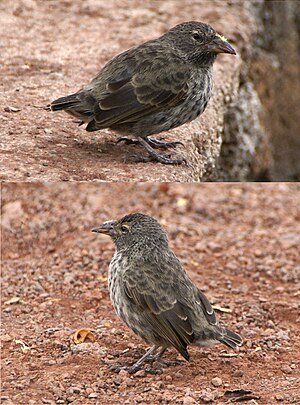
- lisans
- cc-by-sa-3.0
- telif hakkı
- Wikipedia-auteurs en -editors
Geospiza scandens
(
Portekizce
)
wikipedia PT tarafından sağlandı
- lisans
- cc-by-sa-3.0
- telif hakkı
- Autores e editores de Wikipedia
Geospiza scandens: Brief Summary
(
Portekizce
)
wikipedia PT tarafından sağlandı
Geospiza scandens é uma espécie de ave da família Emberizidae.
É endémica do Equador.
Os seus habitats naturais são: florestas secas tropicais ou subtropicais e matagal árido tropical ou subtropical.
- lisans
- cc-by-sa-3.0
- telif hakkı
- Autores e editores de Wikipedia
Mindre kaktusfink
(
İsveççe
)
wikipedia SV tarafından sağlandı
Mindre kaktusfink[2] (Geospiza scandens) är en fågel i familjen tangaror inom ordningen tättingar.[3] IUCN kategoriserar arten som livskraftig.[1]
Mindre kaktusfink förekommer på Galápagosöarna och delas in i fyra underarter med följande utbredning:[3]
-
G. s. scandens – Santiago och Rabida
-
G. s. intermedia – Santa Fé, Floreana, Pinzón, Santa Cruz och Isabela
-
G. s. abingdoni – Pinta
-
G. s. rothschildi – Marchena
Referenser
- ^ [a b] Birdlife International 2012 Geospiza scandens Från: IUCN 2015. IUCN Red List of Threatened Species. Version 2015.2 www.iucnredlist.org. Läst 2015-08-01.
-
^ Sveriges ornitologiska förening (2015) Officiella listan över svenska namn på världens fågelarter Arkiverad 18 oktober 2014 hämtat från the Wayback Machine., läst 2015-07-01
- ^ [a b] Clements, J. F., T. S. Schulenberg, M. J. Iliff, D. Roberson, T. A. Fredericks, B. L. Sullivan, and C. L. Wood (2014) The eBird/Clements checklist of birds of the world: Version 6.9 http://www.birds.cornell.edu/clementschecklist/download, läst 2015-02-01
Externa länkar
- lisans
- cc-by-sa-3.0
- telif hakkı
- Wikipedia författare och redaktörer
Mindre kaktusfink: Brief Summary
(
İsveççe
)
wikipedia SV tarafından sağlandı
Mindre kaktusfink (Geospiza scandens) är en fågel i familjen tangaror inom ordningen tättingar. IUCN kategoriserar arten som livskraftig.
Mindre kaktusfink förekommer på Galápagosöarna och delas in i fyra underarter med följande utbredning:
G. s. scandens – Santiago och Rabida G. s. intermedia – Santa Fé, Floreana, Pinzón, Santa Cruz och Isabela G. s. abingdoni – Pinta G. s. rothschildi – Marchena

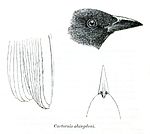
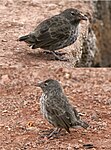
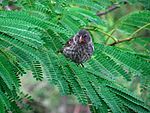
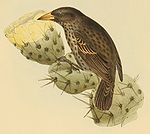
- lisans
- cc-by-sa-3.0
- telif hakkı
- Wikipedia författare och redaktörer
Geospiza scandens
(
Vietnamca
)
wikipedia VI tarafından sağlandı
Geospiza scandens là một loài chim trong họ Thraupidae.[2]
Hình ảnh
Chú thích
Tham khảo
- lisans
- cc-by-sa-3.0
- telif hakkı
- Wikipedia tác giả và biên tập viên
Geospiza scandens: Brief Summary
(
Vietnamca
)
wikipedia VI tarafından sağlandı
Geospiza scandens là một loài chim trong họ Thraupidae.
- lisans
- cc-by-sa-3.0
- telif hakkı
- Wikipedia tác giả và biên tập viên
サボテンフィンチ
(
Japonca
)
wikipedia 日本語 tarafından sağlandı
サボテンフィンチ

サボテンフィンチ Geospiza scandens
保全状況評価 LEAST CONCERN (IUCN Red List Ver.3.1 (2001))  分類 界
分類 界 :
動物界 Animalia 門 :
脊索動物門 Chordata 亜門 :
脊椎動物亜門 Vertebrata 綱 :
鳥綱 Aves 目 :
スズメ目 Passeriformes 科 :
フウキンチョウ科 Thraupidae 属 :
ガラパゴスフィンチ属 Geospiza 種 :
サボテンフィンチ G. scandens 学名 Geospiza scandens (
Gould, 1837)
和名 サボテンフィンチ 英名
Common Cactus Finch サボテンフィンチ (Geospiza scandens) は、フウキンチョウ科のダーウィンフィンチ類に属する鳥類の1種。
ガラパゴス諸島のほとんどの島に生息する固有種であり、ガラパゴス諸島の多くの島々の乾燥地帯に見られるが、フェルナンディナ島、エスパニョラ島、ヘノベサ島、ダーウィン島、ウォルフ島は例外となる。本種が生息しないこれらの島のほとんどには、近縁種であるオオサボテンフィンチが生息する。
生息地は乾燥低木地および疎林であり、通常オプンティア属のサボテンと密接に関係している。オプンティア属のサボテン地帯よりほとんど遠くに行かない。[1]
全長14cm[1]、体重21g[2]。成鳥の雄は全身黒色で、下尾筒に白斑がある。雌および若鳥では上面が灰褐色で、下面に濃密な縞がある。他のガラパゴスフィンチ属とよく似ているが、くちばしは地上フィンチ類に比べてやや長い。[1]
サボテンフィンチは、ダーウィンフィンチ類として知られる近縁種グループの1属である、ガラパゴスフィンチ属に属する6種のうちの1種であり、4亜種が認められている[3][4]。
参考文献[編集]
- ^ a b c d e f g Swash and Stills 2005, p. 104.
-
^ Isabel Castro and Antonia Phillips, A Guide to The Birds of the Galápagos Islands, Prinston University Press, 1996, p. 128. ISBN 0-691-01225-3.
-
^ Swash and Stills 2005, p. 100.
-
^ Clements, James (2007). The Clements Checklist of the Birds of the World (6th ed.). Ithaca, NY: Cornell University Press. p. p. 687. ISBN 978 0 8014 4501 9.
-
^ 藤原幸一 『ガラパゴス博物学』、データハウス、2001年、121-122頁。ISBN 4-88718-616-9。
- Swash, Andy; Still, Rob Birds, Mammals and Reptiles of the Galápagos Islands (2 nd ed.). London: Christopher Helm. (2005). ISBN 978-0-7136-7551-1.
関連項目[編集]
![src=]()
ウィキメディア・コモンズには、
サボテンフィンチに関連するメディアがあります。
![src=]()
ウィキスピーシーズに
サボテンフィンチに関する情報があります。

サボテンフィンチ: Brief Summary
(
Japonca
)
wikipedia 日本語 tarafından sağlandı
サボテンフィンチ (Geospiza scandens) は、フウキンチョウ科のダーウィンフィンチ類に属する鳥類の1種。

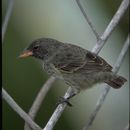
 Esta páxina forma parte del wikiproyeutu Aves, un esfuerciu collaborativu col fin d'ameyorar y organizar tolos conteníos rellacionaos con esti tema. Visita la páxina d'alderique del proyeutu pa collaborar y facer entrugues o suxerencies.
Esta páxina forma parte del wikiproyeutu Aves, un esfuerciu collaborativu col fin d'ameyorar y organizar tolos conteníos rellacionaos con esti tema. Visita la páxina d'alderique del proyeutu pa collaborar y facer entrugues o suxerencies. 






 分類 界 : 動物界 Animalia 門 : 脊索動物門 Chordata 亜門 : 脊椎動物亜門 Vertebrata 綱 : 鳥綱 Aves 目 : スズメ目 Passeriformes 科 : フウキンチョウ科 Thraupidae 属 : ガラパゴスフィンチ属 Geospiza 種 : サボテンフィンチ G. scandens 学名 Geospiza scandens
分類 界 : 動物界 Animalia 門 : 脊索動物門 Chordata 亜門 : 脊椎動物亜門 Vertebrata 綱 : 鳥綱 Aves 目 : スズメ目 Passeriformes 科 : フウキンチョウ科 Thraupidae 属 : ガラパゴスフィンチ属 Geospiza 種 : サボテンフィンチ G. scandens 学名 Geospiza scandens